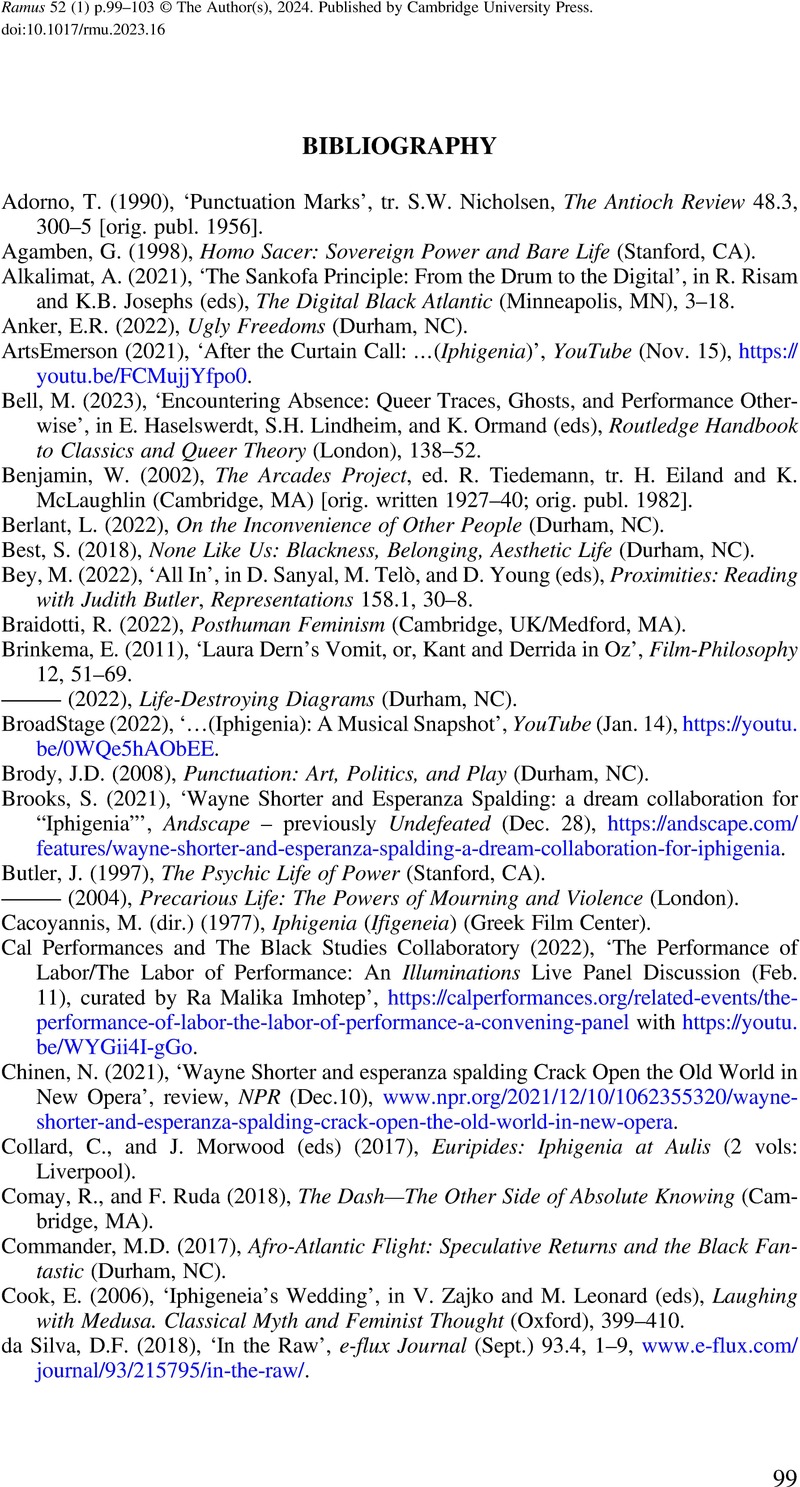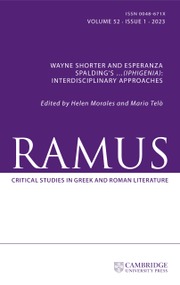No CrossRef data available.
Article contents
BIBLIOGRAPHY
Published online by Cambridge University Press: 24 January 2024
Abstract
An abstract is not available for this content so a preview has been provided. As you have access to this content, a full PDF is available via the ‘Save PDF’ action button.

- Type
- Bibliography
- Information
- Ramus , Volume 52 , Special Issue 1: Wayne Shorter and esperanza spalding's …(Iphigenia): Interdisciplinary Approaches , June 2023 , pp. 99 - 103
- Copyright
- Copyright © The Author(s), 2024. Published by Cambridge University Press
References
Adorno, T. (1990), ‘Punctuation Marks’, tr. S.W. Nicholsen, The Antioch Review 48.3, 300–5 [orig. publ. 1956].Google Scholar
Alkalimat, A. (2021), ‘The Sankofa Principle: From the Drum to the Digital’, in Risam, R. and Josephs, K.B. (eds), The Digital Black Atlantic (Minneapolis, MN), 3–18.Google Scholar
ArtsEmerson (2021), ‘After the Curtain Call: …(Iphigenia)’, YouTube (Nov. 15), https://youtu.be/FCMujjYfpo0.Google Scholar
Bell, M. (2023), ‘Encountering Absence: Queer Traces, Ghosts, and Performance Otherwise’, in Haselswerdt, E., Lindheim, S.H., and Ormand, K. (eds), Routledge Handbook to Classics and Queer Theory (London), 138–52.Google Scholar
Benjamin, W. (2002), The Arcades Project, ed. Tiedemann, R., tr. Eiland, H. and McLaughlin, K. (Cambridge, MA) [orig. written 1927–40; orig. publ. 1982].Google Scholar
Bey, M. (2022), ‘All In’, in D. Sanyal, M. Telò, and D. Young (eds), Proximities: Reading with Judith Butler, Representations 158.1, 30–8.CrossRefGoogle Scholar
Brinkema, E. (2011), ‘Laura Dern's Vomit, or, Kant and Derrida in Oz’, Film-Philosophy 12, 51–69.CrossRefGoogle Scholar
BroadStage (2022), ‘…(Iphigenia): A Musical Snapshot’, YouTube (Jan. 14), https://youtu.be/0WQe5hAObEE.Google Scholar
Brooks, S. (2021), ‘Wayne Shorter and Esperanza Spalding: a dream collaboration for “Iphigenia”’, Andscape – previously Undefeated (Dec. 28), https://andscape.com/features/wayne-shorter-and-esperanza-spalding-a-dream-collaboration-for-iphigenia.Google Scholar
Cal Performances and The Black Studies Collaboratory (2022), ‘The Performance of Labor/The Labor of Performance: An Illuminations Live Panel Discussion (Feb. 11), curated by Ra Malika Imhotep’, https://calperformances.org/related-events/the-performance-of-labor-the-labor-of-performance-a-convening-panel with https://youtu.be/WYGii4I-gGo.Google Scholar
Chinen, N. (2021), ‘Wayne Shorter and esperanza spalding Crack Open the Old World in New Opera’, review, NPR (Dec.10), www.npr.org/2021/12/10/1062355320/wayne-shorter-and-esperanza-spalding-crack-open-the-old-world-in-new-opera.Google Scholar
Collard, C., and Morwood, J. (eds) (2017), Euripides: Iphigenia at Aulis (2 vols: Liverpool).Google Scholar
Comay, R., and Ruda, F. (2018), The Dash—The Other Side of Absolute Knowing (Cambridge, MA).CrossRefGoogle Scholar
Commander, M.D. (2017), Afro-Atlantic Flight: Speculative Returns and the Black Fantastic (Durham, NC).Google Scholar
Cook, E. (2006), ‘Iphigeneia's Wedding’, in Zajko, V. and Leonard, M. (eds), Laughing with Medusa. Classical Myth and Feminist Thought (Oxford), 399–410.Google Scholar
da Silva, D.F. (2018), ‘In the Raw’, e-flux Journal (Sept.) 93.4, 1–9, www.e-flux.com/journal/93/215795/in-the-raw/.Google Scholar
Douglass, F. (1986), Narrative of the Life of Frederick Douglass, an American Slave (New York) [orig. publ. 1845].Google Scholar
Eccleston, S.-M., and Padilla Peralta, D. (2022), ‘Racing the Classics: Ethos and Praxis’, AJP 143.2, 199–218.Google Scholar
Elgutter, C.S. (1902), Iphigenia: A Play in Four Acts (Omaha, NE) [printed for private circulation in 1904].Google Scholar
Florsheim, L. (2020), ‘Frank Gehry Now Begins Every Day With a Swim: “I'm Only 91”’, Wall Street Journal Magazine (Sept. 28), www.wsj.com/articles/frank-gehry-now-begins-every-day-with-a-swim-im-only-91-11601296443.Google Scholar
Gehry, F., et al. (2020), ‘Empowering Design: Gehry Partners, Gehry Technologies, and Architect-Led Industry Change’, Architectural Design 90.2, 14–23.Google Scholar
Gerolemou, M., and Zira, M. (2017), ‘The Architecture of Memory: The Case of Euripides’ Iphigenia in Aulis’, SKENÈ: Journal of Theatre and Dance Studies 3.1, 59–81.Google Scholar
Goldhill, S. (2010), ‘Cultural History and Aesthetics: Why Kant is No Place to Start Reception Studies’, in Hall, E. and Harrop, S. (eds), Theorising Performance: Greek Drama, Cultural History and Critical Practice (Bristol), 56–70.Google Scholar
Greenwood, E. (2010), Afro-Greeks: Dialogues Between Anglophone Caribbean Literature and Classics in the Twentieth Century (New York).Google Scholar
Griffith, M., and Most, G.W., Lattimore, R., Grene, D. (eds) (2013a), Aeschylus. The Oresteia, third edition, tr. Lattimore, R., Griffith, M. (Chicago, IL).Google Scholar
Griffith, M., and Most, G.W., Lattimore, R., Grene, D. (eds) (2013b), Euripides III: Heracles, The Trojan Women, Iphigenia Among the Taurians, Ion, third edition, tr. Arrowsmith, W., Carson, A., Willetts, R.F. (Chicago, IL).Google Scholar
Griffith, M., and Most, G.W., Lattimore, R., Grene, D. (eds) (2013c), Euripides V: Bacchae, Iphigenia in Aulis, The Cyclops, Rhesus, third edition, tr. Arrowsmith, W., Walker, C.R., Lattimore, R. (Chicago, IL).Google Scholar
Gurd, S. (2005), Iphigenias at Aulis: Textual Multiplicity, Radical Philology (Ithaca, NY).Google Scholar
Harney, S., and Moten, F. (2013), The Undercommons: Fugitive Planning & Black Study (Wivenhoe).Google Scholar
Hartman, S. (2019), Wayward Lives, Beautiful Experiments: Intimate Histories of Social Upheaval (New York).Google Scholar
Hartoonian, G. (2002), ‘Frank Gehry: Roofing, Wrapping, and Wrapping the Roof’, The Journal of Architecture 7.1, 1–31.Google Scholar
Haselswerdt, E. (2022), ‘Iphigenia in Aulis—Perhaps (Not)’, in Olsen and Telò (2022), 53–64.Google Scholar
Hickman, J. (2016), Black Prometheus: Race and Radicalism in the Age of Atlantic Slavery (Oxford).Google Scholar
Horkheimer, M., and Adorno, T. (2020), Dialectic of Enlightenment, ed. Schmid Noerr, G., tr. Jephcott, E. (Stanford, CA) [orig. publ. 1947].CrossRefGoogle Scholar
Jackson, Z.Y. (2020), Becoming Human: Matter and Meaning in an Antiblack World (New York).Google Scholar
Jeffers, H.F. (2020), ‘Go Back and Fetch It’, Poetry Foundation (Nov. 30), www.poetryfoundation.org/articles/154884/go-back-and-fetch-it.Google Scholar
Kannicht, R. (ed.) (2004), Tragicorum Graecorum Fragmenta, vol. V. Euripides (Göttingen).CrossRefGoogle Scholar
McCoskey, D. (2018), ‘Black Athena, White Power: Are We Paying the Price for Classics’ Response to Bernal?’, Eidolon by Palimpsest Media (Nov. 15), https://eidolon.pub/black-athena-white-power-6bd1899a46f2.Google Scholar
Mackey, N. (1997), ‘Cante Moro’, in Morris, A. (ed.), Sound States: Innovative Poetics and Acoustical Technologies (Chapel Hill, NC), 194–212.Google Scholar
Mac Sweeney, N., et. al. (2019), ‘Claiming the Classical: The Greco-Roman World in Contemporary Political Discourse’, Council of University Classical Departments Bulletin 48, https://cucd.blogs.sas.ac.uk/files/2019/09/MAC-SWEENEY-ET-AL-Claiming-the-Classical.pdf.Google Scholar
Mallgrave, H. (1996), Gottfried Semper: Architect of the Nineteenth Century (New Haven, CT).Google Scholar
Márquez Martínez, E. (2017), ‘Santa Efigenia/Ifigenia: hagiografía y mito en San Mateo en Etiopía, de Felipe Godínez’, Studia Aurea 11, 319–36.CrossRefGoogle Scholar
Michelakis, P. (2006), ‘Reception, Performance, and the Sacrifice of Iphigenia’, in Martindale, C. and Thomas, R.F. (eds), Classics and the Uses of Reception (Malden, MA), 216–26.Google Scholar
Moten, F. (2003), In the Break: The Aesthetics of the Black Radical Tradition (Minneapolis, MN).Google Scholar
Murchison, G. (2000), ‘“Dean of Afro-American Composers” or “Harlem Renaissance Man”’, in Parsons Smith, C. (ed.), William Grant Still: A Study in Contradictions (Berkeley, CA), 39–65.Google Scholar
Nauck, A. (ed.) (1889), Tragicorum Graecorum Fragmenta, second edition (Leipzig) [repr. Zurich 1964].Google Scholar
Okiji, F. (2018), Jazz as Critique: Adorno and Black Expression Revisited (Stanford, CA).Google Scholar
Olsen, S., and Telò, M. (eds) (2022), Queer Euripides. Re-Readings in Greek Tragedy (London).CrossRefGoogle Scholar
Padilla Peralta, D. (2015), ‘From Damocles to Socrates’, Eidolon by Palimpsest Media (June 8), https://eidolon.pub/from-damocles-to-socrates-fbda6e685c26.Google Scholar
Padilla Peralta, D. (2021), ‘Anti-Race’, in McCoskey, D.E. (ed.), A Cultural History of Race: In Antiquity (vol. 1) (London), 157–71.Google Scholar
Parr, S.M. (2021), Vocal Virtuosity: The Origins of the Coloratura Soprano in Nineteenth Century Opera (Oxford).Google Scholar
Pöhlmann, E., and West, M.L. (eds) (2001), Documents of Ancient Greek Music: The Extant Melodies and Fragments (Oxford).Google Scholar
Prauscello, L. (2006), Singing Alexandria: Music between Practice and Textual Transmission (Mnemosyne Supp. 274: Leiden).Google Scholar
Rabinowitz, N.S., and Bullen, D. (2022), ‘Iphigenia and Artemis? Reading Queer/Performing Queer’, in Olsen and Telò (2022), 197–206.Google Scholar
Rancière, J. (2010), Dissensus: On Politics and Aesthetics, ed. and tr. Corcoran, S. (London).Google Scholar
Rankine, P. (2006), Ulysses in Black: Ralph Ellison, Classicism, and African American Literature (Madison, WI).Google Scholar
Real Magic (2021), ‘Iphigenia—Virtual Fundraiser for Engagement and Access (Sept. 23, 2021)’, https://betterunite.com/iphigeniafundraiser or https://calperformances.org/events/2021%E2%80%9322/jazz/iphigenia-2122/.Google Scholar
Rodríguez, D. (2019), ‘Abolition as Praxis of Human Being: A Foreword’, Harvard Law Review 132, 1575–612.Google Scholar
Saccocia, S. (2021), ‘Iphigenia: New Opera Reimagines Ancient Myth’, Art New England: Contemporary Art and Culture (Nov./Dec.), https://artnewengland.com/iphigenia-new-opera-reimagines-ancient-myth/.Google Scholar
Sánchez, R. (2012), ‘The Black Virgin: Santa Efigenia, Popular Religion, and the African Diaspora in Peru’, Church History 81.3, 631–55.Google Scholar
Shea, A. (2021), ‘Wayne Shorter's Operatic Dream Comes True, Brought to Life with esperanza spalding’, All Things Considered radio program, NPR (Nov. 11), www.npr.org/2021/11/11/1054884119/wayne-shorter-esperanza-spalding-opera.Google Scholar
Small, P.F., Barker, M.J., and Gasman, M. (eds) (2020), Sankofa: African American Perspectives on Race and Culture in US Doctoral Education (Albany, GA).Google Scholar
Smullen, S. (2021), ‘“Iphigenia”, an opera eight years in the making gets its start at Mass MOCA’, The Berkshire Eagle (Nov. 3), www.berkshireeagle.com/arts_and_culture/berkshirelandscapes/esperanza-spalding-wayne-shorter-iphigenia-mass-moca/article_8e99f24c-3be7-11ec-b137-0b2850cd9017.html.Google Scholar
Solga, K. (2008), ‘Body Doubles, Babel's Voices: Katie Mitchell's Iphigenia at Aulis and the Theatre of Sacrifice’, Contemporary Theatre Review 18.2, 146–60.Google Scholar
spalding, e. (2018), 12 Little Spells, produced by e. spalding, M. Stevens, and J. Tyson (Concord Records, Los Angeles, CA).Google Scholar
spalding, e. (2021), ‘Formwela 7 (Official Music Video)’, YouTube (Sept. 24), https://youtu.be/4DY_QNe_3tY.Google Scholar
Spillers, H. (1987), ‘Mama's Baby, Papa's Maybe: An American Grammar Book’, Diacritics 17.2, 64–81.Google Scholar
The Spirituals Project (2004), ‘Literature: African Traditions, Proverbs, and Sankofa’, a multidisciplinary online curriculum, Center for Teaching & Learning, University of Denver, https://web.archive.org/web/20110420131901/http://ctl.du.edu/spirituals/literature/sankofa.cfm.Google Scholar
Stovall, V. (2021), ‘Iphigenia Extended: The Revolutionary Indigestion of Wayne Shorter & esperanza spalding's …Iphigenia’, Corona Borealis blog, Medium (Dec. 12), https://medium.com/corona-borealis/iphigenia-extended-the-revolutionary-indigestion-of-wayne-shorter-esperanza-spaldings-ed2d839f4534.Google Scholar
Stovall, V. (2022), ‘On Dressing Down Myth’, in S. Wong and S.E. Bond (eds), Finding Nowhere series, Public Books (Oct. 2), www.publicbooks.org/on-dressing-down-myth.Google Scholar
Svich, C. (2012), Blasted Heavens: Five Contemporary Plays Inspired by the Greeks (Roskilde).Google Scholar
Swed, M. (2022), ‘Review: Iphigenia, the Wayne Shorter and esperanza spalding way’, Los Angeles Times (Feb. 21), www.latimes.com/entertainment-arts/story/2022-02-21/iphigenia-review-wayne-shorter-esperanza-spalding-frank-gehry.Google Scholar
Taplin, O. (tr.) (2018), Aeschylus: The Oresteia: Agamemnon, Women at the Graveside, Orestes at Athens (New York).Google Scholar
Taylor, K.Y. (2017), How We Get Free: Black Feminism and the Combahee River Collective (Chicago, IL).Google Scholar
Telò, M. (2020b), ‘Between Emotion and the Emetic: Francis Bacon and the Tragic Body at the Margins of the Oresteia’, Literary Imagination 22.2, 109–20.Google Scholar
Telò, M. (2023), Greek Tragedy in a Global Crisis. Reading through Pandemic Times (London).Google Scholar
Wagner, R. (1993), The Art Work of the Future and Other Works, tr. Ellis, W.A. (Lincoln, NE) [orig. publ. 1849].Google Scholar
Walecki, N. (2021), ‘World Premiere of esperanza spalding and Wayne Shorter's Opera, (Iphigenia)’, Harvard Magazine (Nov. 18), www.harvardmagazine.com/2021/11/esperanza-spalding-opera-iphigenia.Google Scholar
Waleson, H. (2021), ‘… (Iphigenia) Review: A Sacrificial Character Finds Her Voice’, Wall Street Journal (Dec. 14), www.wsj.com/articles/iphigenia-wayne-shorter-esperanza-spalding-frank-gehry-11639520430?tesla=y.Google Scholar
Walters, T. (2007), African American Literature and the Classicist Tradition: Black Women Writers from Wheatley to Morrison (New York).Google Scholar
Warren, C. (2018), Ontological Terror: Blackness, Nihilism, and Emancipation (Durham, NC).Google Scholar
Weheliye, A.G. (2014), Habeas Viscus: Racializing Assemblages, Biopolitics, and Black Feminist Theories of the Human (Durham, NC).Google Scholar
Wolfe, R.M.E. (2020), ‘Human Sacrifice, Nuns, and Gender-Bent Kings: The Effect of Religious Change on Gender Presentation in Early Modern Adaptations of Iphigenia among the Taurians’, Ecumenica 13.1, 21–51.Google Scholar
Yaszek, L. (2005), ‘An Afrofuturist Reading of Ralph Ellison's Invisible Man’, Rethinking History 9.2–3, 297–313.Google Scholar


